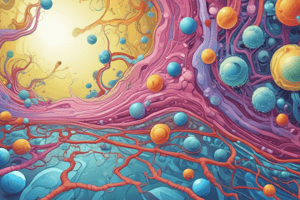Podcast
Questions and Answers
What is the primary function of the cell membrane?
What is the primary function of the cell membrane?
- To regulate what enters and leaves the cell (correct)
- To generate energy for the cell
- To synthesize proteins
- To store genetic information
Which organelle is often referred to as the 'powerhouses' of the cell?
Which organelle is often referred to as the 'powerhouses' of the cell?
- Mitochondria (correct)
- Golgi apparatus
- Endoplasmic reticulum
- Lysosome
What is the main component of the cell membrane?
What is the main component of the cell membrane?
- Cholesterol
- Carbohydrates
- Proteins
- Phospholipid bilayer (correct)
What is the function of the mitochondrial matrix?
What is the function of the mitochondrial matrix?
What is the term for the movement of molecules from high to low concentration without energy input?
What is the term for the movement of molecules from high to low concentration without energy input?
What is the role of cholesterol in the cell membrane?
What is the role of cholesterol in the cell membrane?
What is the term for the arrangement of proteins and lipids in the cell membrane?
What is the term for the arrangement of proteins and lipids in the cell membrane?
What is the function of the mitochondrial inner membrane?
What is the function of the mitochondrial inner membrane?
What is the term for the movement of molecules from low to high concentration using energy input?
What is the term for the movement of molecules from low to high concentration using energy input?
What is the role of plasma membrane proteins and carbohydrates in cell-cell recognition and communication?
What is the role of plasma membrane proteins and carbohydrates in cell-cell recognition and communication?
Study Notes
Cell Membrane
- Also known as the plasma membrane
- Outermost layer of the cell
- Semi-permeable, allowing certain substances to pass through while keeping others out
- Composed of:
- Phospholipid bilayer (main component)
- Proteins (integral and peripheral)
- Cholesterol (stabilizes the membrane)
- Carbohydrates (attached to proteins or lipids)
- Functions:
- Regulates what enters and leaves the cell
- Maintains cell shape
- Provides mechanical support
- Involved in cell signaling and communication
Mitochondria
- Often referred to as the "powerhouses" of the cell
- Found in eukaryotic cells
- Responsible for generating most of the cell's energy (ATP) through cellular respiration
- Composed of:
- Outer membrane
- Inner membrane (highly folded, increases surface area)
- Intermembrane space
- Mitochondrial matrix (site of citric acid cycle and fatty acid oxidation)
- Functions:
- Generates ATP through cellular respiration (aerobic and anaerobic)
- Regulates cell growth and division
- Involved in apoptosis (programmed cell death)
- Maintains cellular calcium levels
Plasma Membrane (additional details)
- Fluid mosaic model: describes the arrangement of proteins and lipids in the membrane
- Selective permeability: allows certain substances to pass through while keeping others out
- Passive transport: movement of molecules from high to low concentration without energy input (diffusion, osmosis, facilitated diffusion)
- Active transport: movement of molecules from low to high concentration using energy input (carrier proteins, pumps)
- Cell-cell recognition and communication: plasma membrane proteins and carbohydrates involved in cell adhesion and signaling
Cell Membrane
- The outermost layer of the cell, also known as the plasma membrane
- Semi-permeable, allowing certain substances to pass through while keeping others out
- Composed of a phospholipid bilayer, proteins, cholesterol, and carbohydrates
- Phospholipid bilayer is the main component, with hydrophilic heads and hydrophobic tails
- Proteins are integral (span the membrane) or peripheral (attached to the surface)
- Cholesterol stabilizes the membrane, while carbohydrates are attached to proteins or lipids
- Regulates what enters and leaves the cell, maintaining cell shape and providing mechanical support
- Involved in cell signaling and communication
Mitochondria
- Found in eukaryotic cells, responsible for generating most of the cell's energy (ATP)
- Composed of outer and inner membranes, intermembrane space, and mitochondrial matrix
- Inner membrane is highly folded, increasing surface area for energy production
- Mitochondrial matrix is the site of citric acid cycle and fatty acid oxidation
- Generates ATP through cellular respiration (aerobic and anaerobic)
- Regulates cell growth and division, involved in apoptosis (programmed cell death)
- Maintains cellular calcium levels
Plasma Membrane Function
- Fluid mosaic model describes the arrangement of proteins and lipids in the membrane
- Selective permeability allows certain substances to pass through while keeping others out
- Passive transport: diffusion, osmosis, and facilitated diffusion (no energy input)
- Active transport: movement of molecules from low to high concentration using energy input
- Cell-cell recognition and communication involve plasma membrane proteins and carbohydrates
- Cell adhesion and signaling are also mediated by plasma membrane proteins and carbohydrates
Studying That Suits You
Use AI to generate personalized quizzes and flashcards to suit your learning preferences.
Description
Learn about the cell membrane, its composition, and functions in regulating cellular activities. Explore the phospholipid bilayer, proteins, cholesterol, and carbohydrates that make up this crucial layer.




